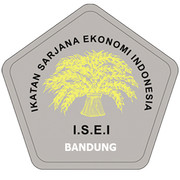FAKTOR KUNCI KESUKSESAN STUDENTPRENEUR
Abstract
Situasi dan kondisi di Indonesia menunjukkan tingkat pengangguran yang tinggi, termasuk tingkat pengangguran terpelajar pada usia muda. Salah satu cara untuk mengatasinya adalah dengan memberikan dorongan untuk berwirausaha. Masalahnya ada bila ada minat rendah terhadap kewirausahaan di kalangan anak muda, terutama mahasiswa. Oleh karena itu perlu untuk membangkitkan semangat wirausaha mereka melalui pendidikan kewirausahaan sebagai proses belajar sepanjang hayat (longlife learning process). Tujuan dari penelitian ini adalah untuk mengetahui dan membandingkan faktor kunci keberhasilan wirausaha di tiga perguruan tinggi di Indonesia yaitu UPI, UNPAD dan ITB. Penelitian dilakukan terhadap 300 pengusaha mahasiswa dari tiga universitas dengan teknik random sampling. Faktor keberhasilan utama diukur dengan 1) Prosedur teknis 2) Struktur perusahaan 3) Sumber daya manusia di perusahaan 4) Struktur keuangan perusahaan dan 5) Pemasaran dan Produktifitas. Hasilnya menunjukkan bahwa titik tertinggi terletak pada prosedur teknis sedangkan yang terendah adalah sumber daya manusia di perusahaan. Secara keseluruhan, tidak ada perbedaan signifikan pada faktor kunci keberhasilan wirausaha di tiga universitas. Pengembangan sumber daya manusia harus ditingkatkan dalam hal omset, perilaku, dan komitmen.
Keywords
Full Text:
PDFReferences
Ayadurai, S., & Ahmad, W. (2006). A study on the critical success factors of women entrepreneurs in small and medium enterprises (SMEs) in Malaysia. Paper presented at the International Council for Small Business (ICSB) 51st World Conference, Melbourne.
Baghai, M., Coley, S., & White, D. (2000). The Alchemy of Growth,. New York, NY: Basic Books.
Baum, R. (1994). The Relation of Trait, Competencies, Vision, Motivation, and Strategy to Venture Growth. Unpublished Doctoral Dissertation, University of Maryland.
Bercovitz, J., & Feldman, M. (2008). 'Academic Entrepreneurs: Organizational Change at the Individual'. Organization Science, vol. 19, no. 1, pp. 69-89.
Bisp, S., Sorensen, E., & Grunert, K. (2001). Using the key success factor concept in competitor intelligence and benchmarking. Competitive Intelligence Review, 9(3), 55-67.
Biro Pusat Statistik. (2016).
Chandler, G., & Jansen, E. (1992). The founder’s self-assessed competence and venture performance. J. Business Venturing, pp: 223-236.
Chen, Y., & Lai, M. (2010). Factors influencing the entrepreneurial attitude of Taiwanese tertiary-level business students. Social Behavior and Personality: an international journal, 38(1), 1-12.
Foley, P., & H, G. (1989). Small business success. London: Chapman.
Gaffar, Vanessa and Heny Hendrayati. (2016). Peningkatan Spirit Kewirausahaan Melalui Pendidikan Kewirausahaan sebagai suatu Lifelong Learning Process. Laporan Akhir Hibah Strategi Naisonal.
Gaskill, G., & Hyland, J. (1989). Starting and managing a small business. Strategic Finance,
(6), 28.
Ghosh, B., Liang, T., Meng, T., & Chan, B. (2001). The key success factors, distinctive capabilities and strategic thrust of top SMEs in Singapore. Journal Business Research, 51, 209-221.
Gibb, A. (1994). Do we really teach (Approach) small business the way we should? Journal of Small Business and Entrepreneurship, 11(2),, 4-27.
Gorman, G., Hanlon, D., & King, W. (1997). Some research perspectives on entrepreneurship education, enterprise education and education for small business management: A ten-year literature review. International Small Business Journal, 15(3), 56-77.
Hashim, M. (2000). A proposed strategic Framework for SMEs success. Malaysian Management Review, 35(2), 32-43.
Hashim, M., Mahajar, A., & Ahamd, S. (2003). Innovative practices of Malaysian Firms: Some evidence from Enterprise 50 Winners. Malaysian Management Review, 38 (2), 19-27.
Hesselmann, H., & Comcare, P. (2002). Benchmarking national and regional e-business policies for SMEs. Final report of the “E-business Policy Group.
Hitt, M., & Ireland, R. (2000). The intersection of entrepreneurship and strategic management research. Handbook of entrepreneurship, 45-63.
Huggins, R. (2000). The success and failure of policy-implanted inter-firm network initiatives: motivations, processes and structure.
Entrepreneurship and Regional Development, 12(2), p.211-236.
Hung, D., Effendi, A., Talib, L., & Rani, N. (2011). A preliminary study of top SMEs in Malaysia: Key success factor vs Government support program. Journal of Global Business and Economics, 2(1), 48-58.
Indarti, N., & Langenberg, M. (2005). A study of factors affecting business success among SMEs: Empirical evidences from Indonesia. Asian Social Science, 7(5), 67-86.
Jarillo, J. (1988). On strategic networks. Strategic Management Journal, 9(1), p.31-41.
Kourilsky, M., & Walstad, W. (1998). Entrepreneurship and female youth: Knowledge, attitude, gender differences, and educational practices. Journal of Business Venturing, 13(1), 77-88.
Kristiansen, S., Furuholt, B., & Wahid, F. (2003). Internet cafe entrepreneurs: pioneers in information dissemination in Indonesia. The International Journal of Entrepreneurship and Innovation, 4(4), p.251-263.
Lin, C., (1998). Success Factors of Small and Medium-Sized Enterprises in Taiwan: An Analysis of Cases, Journal of Small Business Management, 36 (4).
Man, M., & Wafa, S. (2007). The relationship between distinctive capabilities and the performance of small and medium-size enterprises (SMEs) in Malaysia. In Proceedings of the 13th Asia Pacific Management Conference, Melbourne, Australia, 11-19.
Manik, E., & Sidharta, I. (2016). Entrepreneurial Intention on Studentpreneurs to become Entrepreneur. International Review of Management and Marketing, 6, 3.
Marchand, J., & Hermens, A. (2015). Student entrepreneurship: A research agenda. International Journal of Organizational Innovation (Online), 8(2), 266.
Mahrouq, Maher AL (2010) Success Factors Of Small And Medium-Sized Enterprises (Smes): The Case Of Jordan. Anadolu University Journal Of Social Sciences Cilt/Vol.: 10- Sayı/No: 1 : 1–16 (2010
Mars, M., Slaughter, S., & Rhoades, G. (2008). 'The State-Sponsored Student Entrepreneur'. The Journal of Higher Education, vol. 79, no. 6, pp. 638-70.
McMahon, R. (2001). Growth and performance of manufacturing SMEs: The influence of financial management characteristics. International Small Business Journal, 19(3), p.10-28.
Naffziger, D., Hornsby, J., & Kuratko, D. (1994). A proposed research model of entrepreneurial motivation. Entrepreneurship Theory and Practice, 18(3), 29-43.
Nora, A., Cabrera, A., Hagedorn, L., & Pascarella, E. (1996). Differential impacts of academic and social experiences on college-related behavioral outcomes across different ethnic and gender groups at four-year institutions gender groups at four-year institutions. Research in Higher Educati. Research in Higher Education, 37(4), 427–451.
Ogunyemi, J. (2011). How to be a Student Entrepreneur. Ecademy Press.
Pascarella, E., & Terenzini, P. (2005). How college affects students (Vol. 2): A third decade of research. San Francisco: Jossey-Bass/Wiley.
Perna, L. (2006). Studying college choice: A proposed conceptual model. In J.C. Smart (Ed.), Higher education: Handbook of theory and research. New York: Springer Publishing.
Philip, M. (2011). Factors affecting business success of small & medium enterprises (SMEs). Amity Global Business Review, 6(1), 118-136.
Politis, D., Winborg, J., & Dahlstrand, Å. (2012). Exploring the resource logic of student entrepreneurs. International Small Business Journal, 30(6), pp. 659-683.
Rose, R., Kumar, N., & Yen, L. (2006). Entrepreneurs success factors and escalation of small and medium-sized enterprises in Malaysia. Journal of Social Sciences, 2(3), 74-80.
Rose, R., Kumar, N., & Yen, L. (2006). Entrepreneurs success factors and escalation of small and medium-sized enterprises in Malaysia. Journal of Social Sciences, 2(3), 74-80.
Rutherford, M., & Oswald, S. (2000). Antecedents of small business performance. New England Journal of Entrepreneurship, 3(2), 21.
Sen, B. and Taylor, R., (2007). Determining the Information Needs of Small and Medium-Sized Enterprises: A Critical Success Factors Analysis, Information Research, 12 (4).
Shay, J., & Terjensen, S. (2005). Entrepreneurial aspirations and intentions of business students: A gendered perspective. Paper presented at the Babson Entrepreneurship Conference, Boston, MA.
Shinnar, R., Hsu, D., & Powell, B. (2014). Self-efficacy, entrepreneurial intentions, and gender: Assessing the impact of entrepreneurship education longitudinally. The International Journal of Management Education, 12, 561-570.
Sidharta, I., & Lusyana, D. (2014). Analisis faktor penentu kompetensi berdasarkan konsep knowledge, skill, dan ability (KSA) Di Sentra Kaos Suci Bandung. Jurnal Computech & Bisnis, 8(1), 49-60.
Sinha, A. (2003). Experience of SMEs in south and south-east Asia. South Asia Enterprise Development Facility, 1-18.
St. John, E. (2003). Refinancing the college dream: Access, equal opportunity, and justice for taxpayers. Baltimore, MD: The Johns Hopkins University Press.college-related behavioral outcomes across different ethnic and gender groups at four-year institutions. Research in Higher Education, 37(4), 427–451.
Swierczek, F., & Ha, T. (2003). Entrepreneurial orientation, uncertainty avoidance and firm performance: an analysis of Thai and Vietnamese SMEs. International Journal of Entrepreneurship and Innovation, 4(1), p.46-58.
Tinto, V. (1993). Leaving college: Rethinking the causes and cures of student attrition (2nd ed.). Chicago: The University of Chicago Press.esearch in Higher Education, 37(4), 427–451.
Torenberg, E. (2012). Find Your Inner Entrepreneur. The Michigan Daily.
Wang, C., & Wong, P. (2004). Entrepreneurial interest of university students in Singapore. Technovation, 24(2), 163-172.
Wiklund, J. (1998). Small Firm Growth and Performance Entrepreneurship and Beyond. Internationella Handelshögskolan.
Willard, G., Krueger, D., & Feeser, H. (1992). In order to grow, must the founder go: A comparison of performance between founder and non-founder managed high-growth manufacturing firms. Journal of Business Venturing, 7(3),, 181-194.
William, G., James, M., & Susan, M. (2005). Fundamentals of Business: Starting a Small Business. New York: McGraw-Hill/Irwin.
Wu, Sizong & Wu, Lingfei. (2008). The impact of higher education on entrepreneurial
intentions of university students in China. Journal of Small Business and Enterprise Development. Vol. 15 No. 4, 2008. pp. 752-774. Emerald Group Publishing Limited
Zimmerer, W., & Scarborough, N. (1996). Entrepreneurship and The New Venture Formation.
New Jersey: Prentice Hall International, Inc.
DOI: https://doi.org/10.17509/image.v7i2.22240
Refbacks
- There are currently no refbacks.
Copyright (c) 2019 Vanessa Gaffar
Image : Jurnal Riset Manajemen is licensed under a Creative Commons Attribution-ShareAlike 4.0 International License
View My Stats



